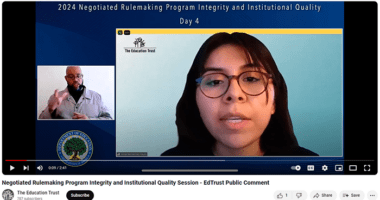College Leaders Share Why Year-Round Pell Is Important for Their Students
UPDATED
Today, we learned that Congress wants to restore year-round Pell grants in its plan to fund the government for the rest of this year. We’ve already talked about why we think year-round Pell is important. But we aren’t the only ones. We asked college leaders in our OASIS Network, a group of 10 institutions working to improve degree attainment among historically underserved populations, and here’s what they had to say:
Year-round Pell caters to the demands of today’s college students. “Access to Pell funds year-round is critical to providing students with significant financial challenges the best chance to succeed. Many of these students juggle competing demands, including multiple jobs, during the year that often result in them having to take less than 15 hours per semester,” said President M. David Rudd, of the University of Memphis, where 47 percent of undergraduate students receive Pell. “Summer Pell funds would allow them to stay on track, reduce graduation times, and lower overall student debt. Year-round Pell is an investment in student success, one with a solid empirical foundation.”
Year-round Pell connects students with opportunities. “Of the many bridges created to provide equitable access to higher education for the diverse students of this nation, few have been — or ever will be — as impactful as the Pell Grant. Nearly half of California State University–Fullerton’s undergraduate students receive the Pell award, and the support it provides them with can be the difference between achieving the American Dream or falling short of it with much debt and no degree,” said President Mildred García. “Many of these students juggle responsibilities that impede their ability to graduate in the same time frame as their peers, underscoring the moral imperative to provide them with year-round opportunities to complete their degree on time and begin their invaluable contributions in the workforce of a democratic, just society. That is the transformative power of year-round Pell.”
Year-round Pell saves students money and time. “Two of the most important things for students is time to a degree and money to degree. And when you have students who are underserved and from low socioeconomic backgrounds, the opportunity to continue their education through the summer is paramount. It allows them flexibility and the ability to continue their education uninterrupted,” said Vice President of Student Affairs Frank R. Lamas, of Fresno State University, where 56 percent of undergraduate students receive Pell. “If you put the right support services and programs around underserved students and students with low socioeconomic standing, they can succeed at high rates — the same as (and sometimes higher than) their peers. And year-round Pell is one of those important support services. If we want students to finish in four-to-five years, year-round Pell can help them do that. What better way to invest in our future and that of our youth than through a college education?”
Year-round Pell provides flexibility. “For students who are pursuing higher education while coping with the challenges of a disability, year-round Pell funding would help ensure their successful completion of a degree,” said President Félix V. Matos Rodríguez, of Queens College, where 40 percent of undergraduate students receive Pell. “A Queens College student who uses an electronic wheelchair has indicated that factors such as surgery and equipment breakdowns can at times prevent her from finishing a semester. If Pell funding was increased, she would plan to use it for summer school classes as a way to make up for falling behind during the regular academic year. Increased Pell funding would help place all of our students on equal academic footing.”
Simply put: “Our hardworking students want to attend year-round,” said President Mark B. Rosenberg, of Florida International University, where 55 percent of undergraduate students receive Pell. “Summer Pell is the key to their version of the American Dream.”
Photo credit: Aaron Hawkins












